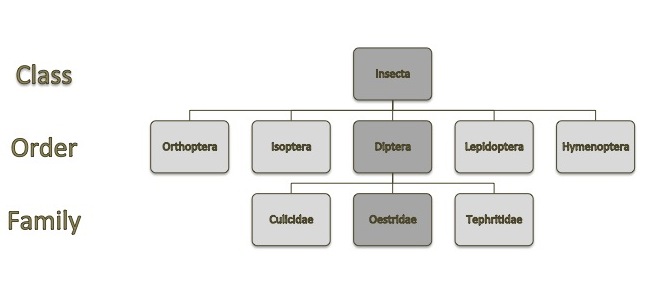Classification
Domain: Eukarya
Kingdom: Animalia
Phylum: Arthropoda
Class: Insecta
Order: Diptera
Family: Oestridae
Genus: Gasterophilus
Species: Gasterophilus intestinalis
Domain: Eukarya
Eukarya includes all organisms with a true nucleus. A nucleus
contains genetic material that controls the cell. They also have
membrane-bound organelles that carry out specialized functions for
the cell.
Kingdom: Animalia
Animalia includes heterotrophic organisms. They are unable to
produce their own food like plants, so they must consume other
organisms. They are multicellular and motile.
Phylum: Arthropoda
A synapomorphy for Arthropods is a jointed exoskeleton of chitin
that they shed as they grow. It is separated into a head, thorax and
abdominal region. An exoskeleton serves as protection against
predators and as a support structure for internal tissues. Joints
allow for better movement. To learn more about the phylum Arthropoda
click
here.
Class: Insecta
Hexapoda refers to insecta, meaning split up into segments (Biology,
1997). These organisms have three pairs of limbs, three body
regions, wings, antennae, and compound eyes (Bug Guide, 2003).
Order: Diptera
Diptera includes flies that have a pair, or two wings, total. Most
have compound eyes and an antennae (Resh and Cardé, 2003).
Family: Oestridae
Oestridae include parasitic fly larvae that develop in their host
(Featured Creatures, 1996).
Genus & Species: Gasterophilus intestinalis
Gasterophilus refers to the common host the organism infects, which
is the horse. Gasterophilus intestinalis refers to the location the
organism infects in the host, which is the digestive tract (Featured
Creatures, 1996).
Phylogenetic Trees:
.jpg) Gasterophilus intestinalis is similar to its relatives in the
phylum Arhtropoda in that, as stated above, Arthropods are know for
their exoskeleton separated into various regions. It shares a common
ancestor with organisms in Arachnida, Malacostraca and many other
classes within Arthropoda. Arachnida includes spiders, such as the
Sydney Funnel-Web Spider. These organisms differ from the
Insecta in that they have more legs and less body regions.
Malacostraca includes crayfish and crabs, such as the
Yeti Crab. These organisms also differ from Insecta in
that they have more legs and less body regions. Insecta is the
largest reservoir of organisms. Many organisms have still yet to be
discovered (Biology, 1997).
Gasterophilus intestinalis is similar to its relatives in the
phylum Arhtropoda in that, as stated above, Arthropods are know for
their exoskeleton separated into various regions. It shares a common
ancestor with organisms in Arachnida, Malacostraca and many other
classes within Arthropoda. Arachnida includes spiders, such as the
Sydney Funnel-Web Spider. These organisms differ from the
Insecta in that they have more legs and less body regions.
Malacostraca includes crayfish and crabs, such as the
Yeti Crab. These organisms also differ from Insecta in
that they have more legs and less body regions. Insecta is the
largest reservoir of organisms. Many organisms have still yet to be
discovered (Biology, 1997).
Figure 1. Phylogenetic tree of Gasterophilus intestinalis that includes domain, kindgom, phylum, class and respective relatives.
The order Diptera is within the class Insecta, and Diptera
organisms share a common ancestor with organisms in the orders
Orthoptera, Isoptera, Lepidoptera and Hymenoptera. Orthoptera and
Isoptera both differ from Diptera in that these organisms’ wings
grow outside of an encasement. Orthoptera include grasshoppers like
the
Short-horned Grasshopper, while Isoptera include termites.
Lepidoptera and Hymenoptera are similar to Dipt era in that these
organisms’ wings grow inside of an encasement until they morph into
an adult stage. Lepidoptera include butterflies like the
Eastern Swallowtail Butterfly, while Hymenoptera include bees
and ants like the
Black Carpenter Ant (Biology, 1997). Families within the order
Diptera are classified by how they acquire nutrition. The family
Culicidae includes
mosquitoes, whose source of energy is blood that they acquire
through biting.
Horse flies in the family Tabanidae also bite. The family Tephritidae includes fruit flies, whose
source of energy is plant tissue. Other families within the order
Diptera include decomposers and those that prey on organisms within
the class Hexapoda. Gasterophilus intestinalis, however, is within
the parasitic family Oestridae (General Entomology, 2013). Another
parasitic fly is the
Warble Fly.
era in that these
organisms’ wings grow inside of an encasement until they morph into
an adult stage. Lepidoptera include butterflies like the
Eastern Swallowtail Butterfly, while Hymenoptera include bees
and ants like the
Black Carpenter Ant (Biology, 1997). Families within the order
Diptera are classified by how they acquire nutrition. The family
Culicidae includes
mosquitoes, whose source of energy is blood that they acquire
through biting.
Horse flies in the family Tabanidae also bite. The family Tephritidae includes fruit flies, whose
source of energy is plant tissue. Other families within the order
Diptera include decomposers and those that prey on organisms within
the class Hexapoda. Gasterophilus intestinalis, however, is within
the parasitic family Oestridae (General Entomology, 2013). Another
parasitic fly is the
Warble Fly.
Figure 2. Phylogenetic tree of Gasterophilus intestinalis that inclues class, order, family and respective relatives.
Now that you know classification, let's take a look at the horse bot fly's habitat!
Want to go home?